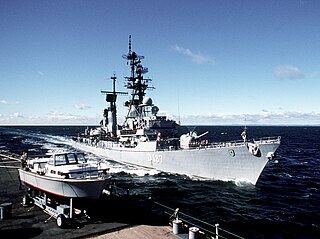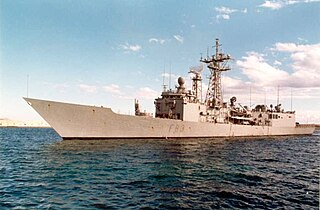Variants
MEKO 360H1
A single vessel of the MEKO 360H1 variant was produced for the Nigerian Navy. Called NNS Aradu, it is one of the largest vessels of that navy.
MEKO 360H2
Six vessels were ordered and four vessels of a second variant, MEKO 360H2, were constructed for Argentina. They were locally named the Almirante Brown class. They are considered frigates and destroyers by different publications. The design is based on the concept of modular systems and is capable of changing the armament of the ship swiftly and can be modernized/refitted with more ease.
The ships have a standard displacement of 2,900 long tons (2,900 t) and 3,360 long tons (3,410 t) at full load. The vessels are 125.9 metres (413 ft 1 in) long overall and 119.0 metres (390 ft 5 in) between perpendiculars with a beam of 15 metres (49 ft 3 in) and a draught of 5.8 metres (19 ft 0 in). The vessels are powered by a COGOG system driving two shafts composed of two Olympus TM 3B gas turbines rated at 51,800 shaft horsepower (38,600 kW) and two Tyne RM-IC gas turbines rated at 10,200 shaft horsepower (7,600 kW). The ships have a maximum speed of 30.5 knots (56.5 km/h; 35.1 mph) while using their Olympus gas turbines at 18 knots (33 km/h; 21 mph) using their Tyne turbines. The MEKOs have a maximum range of 4,500 nautical miles (8,300 km; 5,200 mi) at 18 knots.
The Argentinian vessels are armed with eight Exocet surface-to-surface missiles in two quad launchers mounted centrally and one octuple launcher for Aspide surface-to-air missiles mounted aft of the superstructure. The MEKO 360H2 are also equipped with one OTO Melara 5-inch (130 mm)/54 calibre naval gun forward of the superstructure, eight Bofors 40 mm/70 calibre guns, and two triple-mounted 324-millimetre (12.8 in) ILAS torpedo tubes.

HMS Amazon was the first Type 21 frigate of the Royal Navy. Her keel was laid down at the Vosper Thornycroft shipyard in Southampton, England. The ship suffered a fire in the Far East in 1977, drawing attention to the risk of building warships with aluminium superstructure.

USS Sellers (DDG-11) was a Charles F. Adams-class guided-missile destroyer built for the United States Navy in the 1950s.

The German destroyer D187 Rommel was one of three Lütjens-class guided-missile destroyers, a modified version of the American Charles F. Adams class, built for the Bundesmarine during the 1960s.

HMCS Yukon was a Mackenzie-class destroyer that served in the Royal Canadian Navy (RCN) and later the Canadian Forces. She was the first Canadian naval unit to carry the name. She was named for the Yukon River that runs from British Columbia through Yukon and into Alaska in the United States.

Reina Sofía (F84) is the fourth of six Spanish-built Santa María-class frigates of the Spanish Navy. The Santa María class is based on the American Oliver Hazard Perry-class design, providing an anti-air warfare platform with anti-submarine and anti-surface warfare capabilities at a reduced cost. Reina Sofía was constructed by Bazan and was laid down on 12 October 1987 and launched on 19 July 1989. The ship was commissioned in 1990 and has seen service in the Mediterranean Sea and off Somalia.

Numancia (F83) is the third of the six Spanish-built Santa Maria-class frigates of the Spanish Navy, based on the American Oliver Hazard Perry class design. The frigate was constructed in Spain by Bazan and laid down on 8 January 1986; launched on 29 January 1987; and entered service with the Spanish Navy on 17 November 1989. Based at Rota, Numancia has been deployed to the Indian Ocean to fight piracy in Somalia as part of Operation Atalanta and to the Mediterranean Sea to intercept illegal trafficking of migrants as part of Operation Sophia.

HNLMS Jan van Brakel (F825) was a frigate of the Kortenaer class in service with the Royal Netherlands Navy from 1983 to 2001. She was renamed HS Kanaris (F464) on transfer to the Hellenic Navy in 2002.

The Almirante Brown class is a class of warships built for the Argentine Navy. They were commissioned between 1983 and 1984, after the Falklands War. The class comprised four ships; Almirante Brown, La Argentina, Heroína and Sarandí. Heronia was retired in 2024 after a period of prolonged inactivity.

The Kortenaer class was a class of anti-submarine frigates of the Royal Netherlands Navy. Like other frigate types of the 1970s and 1980s, they featured a COGOG propulsion system with separate cruise and sprint gas turbines. Ten were built by De Schelde in Vlissingen and two by Wilton-Fijenoord in Schiedam between 1978 and 1982. Only ten served with the Royal Netherlands Navy: two were sold to Greece's Navy while still under construction and replaced by two Jacob van Heemskerck-class frigates which were an air defence variant of the Kortenaer class. The Greek frigates were renamed the Elli class. After service with the Dutch ended, eight of the frigates were sold to Greece in 1992 and the remaining two to the United Arab Emirates. Three of the ships have since been retired from active military service with one converted into the superyacht Yas.

The Wielingen class is a class of four multi-functional frigates constructed for and operated by the Belgian Naval Component. In service from 1976 to 2008 with the Belgians, three of the class were sold to Bulgaria for service with the Bulgarian Navy beginning in 2004. The fourth, Westhinder, ran aground in 1988, was decommissioned in 1993 and was scrapped.

NNS Aradu (F89) is a Nigerian frigate. She is the first of the MEKO 360 general purpose frigates built by the German Blohm + Voss company of Hamburg. The 125.6-metre ship is the largest in the Nigerian Navy. As a general purpose frigate, Aradu has capabilities for anti-air, anti-surface and anti-submarine warfare effectively, and participated in the 200th anniversary celebrations of the Battle of Trafalgar. The ship also possesses capability for naval fire support and electronic warfare. Additionally, she carries a ship-borne helicopter for anti-submarine warfare, search and rescue, and enhanced surveillance/detection.

USS Donald B. Beary (FF-1085) was a Knox-class frigate built for the United States Navy.

The Churruca class was a Spanish destroyer class built for the Spanish Navy based on a British design. Eighteen ships were built, with two being sold to Argentina and commonly referred to as the Cervantes class. The last two members of the class are sometimes referred to as a separate class, the Alava class.
Dat Assawari was a frigate operated by the Libyan Navy. The ship was built by VT Group in the United Kingdom. It was ordered in February 1968 and delivered in 1973. The ship's design, the Vosper Mk 7 is a modified version of the Alvand-class frigate built for the Iranian Navy. The ship had an extensive refit in Italy by CNR Riva Trigoso 1979–1980 when new sensors and missiles were installed. During the refit, the ship was mined by French commandos from SDECE. The vessel returned to service in 1983, but returned to Italy for repairs in 1984–1985 and 1989–1990. The frigate was reportedly scrapped in the late 1990s.

HNLMS Van Kinsbergen (F809) was a frigate of the Kortenaer class. The ship was in service with the Royal Netherlands Navy from 1980 to 1995. The frigate was named after Dutch naval hero Jan Hendrik van Kinsbergen.

Drazki is a Wielingen-class frigate of the Bulgarian Navy. Originally constructed for and operated by the Belgian Naval Component as Wandelaar, the frigate was designed as a platform capable of multiple uses as an escort during the Cold War in the North Sea and English Channel. The vessel uses weapons and sensor technology from NATO counterparts, which was one of the reasons the ship was acquired by the Bulgarian Navy in 2004. The frigate is currently in active service.

The Sa'ar 2 class ("Shalechet") is a class of missile boats built in Cherbourg, France at the Constructions Mécaniques de Normandie shipyard based on Israeli Navy modification of the German Navy's Jaguar-class fast attack craft. Three of the ships class were converted from Sa'ar 1-class patrol boats in 1974.

HNoMS Oslo was an Oslo-class frigate of the Royal Norwegian Navy. The frigate was launched on 17 January 1964, and commissioned on 29 January 1968. Oslo ran aground near Marstein Island on 24 January 1994. One officer was killed in the incident. The next day, on 25 January, she was taken under tow. However as the situation deteriorated, the tow was let go and the frigate sank.

HNLMS Kortenaer (F807) was a frigate of the Kortenaer class. The ship was in service with the Royal Netherlands Navy from 1978 to 1997 and today serves as HS Kountouriotis with the Hellenic Navy. The frigate was initially named after Dutch naval hero Egbert Bartholomeusz Kortenaer and then after Pavlos Kountouriotis, distinguished Admiral of the Hellenic Navy, responsible for Greek naval victories in the Aegean Sea that secured the Aegean for Greece during the First Balkan War. The ship's radio call sign was "PADA".

HNLMS Callenburgh (F808) was a frigate of the Kortenaer class. The ship was in service with the Royal Netherlands Navy from 1979 to 1994. The frigate was named after Dutch naval hero Gerard Callenburgh. The ship's radio call sign was "PADB".



















